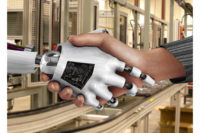Dispensing With Six-Axis Robots
Because of their precision, reach and agility, six-axis robots are a natural for dispensing adhesives, sealants and other materials. In the automotive industry, for example, robots are employed to dispense a variety of one- and two-part materials, including adhesives, formed-in-place gaskets, lubricants, sealants, sound deadeners and structural foams. Similarly, window and door manufacturers use six-axis robots to apply adhesives and gaskets, while appliance assemblers employ six-axis robots to dispense adhesives, gaskets and insulation.
In practice, assemblers have two options for dispensing with six-axis robots. Most often, the dispenser is mounted to the robot. The metering equipment is located on or near the robot, and the material is transferred through one or more hoses to a valve attached to the robot's end effector.
Another option is to mount the dispenser in a fixed position 5 to 12 feet off the ground and use a robot to move the part beneath the valve. The advantage of this configuration is that it allows a robot to move a part through a series of process steps. For example, the robot can pick up a part from a conveyor, pass it beneath the dispenser, present it to a resistance welder and then place it on a second conveyor.
Occasionally, assemblers will mount a pair of valves on a single robot, so it can dispense two materials or two bead patterns. Another possibility is to have a pair of robots working in tandem: one holding the dispenser, while the other holds the part.
When thinking about robotic dispensing, assemblers need to keep in mind a number of variables, including material viscosity, dispensing pressure, robot speed, the dispense path and the height, or "standoff" height, of the nozzle above the workpiece.
Viscosity, in particular, can be tricky, because the material must travel a considerable distance to get from the reservoir to the part. As a result, the feed hoses and reservoir may have to be heated or insulated to isolate the system from swings in ambient temperature.
When thinking about speed, assemblers need to remember there is often a delay between when a dispenser is actuated and when the material starts moving. This delay can cause a gap at the start of the bead, if the robot begins moving before the material does. Similarly, if the robot pauses a split-second before starting to move, there could be a surge of material at the start of the bead.
In terms of standoff height, placing the nozzle too far above the workpiece can allow the bead to swirl and stray from the desired path. On the other hand, placing the nozzle too close can cause the material to accumulate ahead of the tip and producing a flat, misshapen bead. Worse still, the nozzle could crash into the workpiece, damaging the part or the dispenser.
There are several ways to avoid these problems. One is to tighten the tolerances for locating the parts in their fixtures. Another is to equip the dispensing valve with an inductive distance sensor, which provides height data to the robot controller.
Assemblers can also use machine vision to ensure that material is dispensed accurately. The camera can be mounted in a fixed position above the dispensing station, or for greater flexibility, to the robot arm itself. When a part arrives at the dispensing station, the vision system determines the exact position of various reference points, and adjusts the dispense path accordingly.
Looking for a reprint of this article?
From high-res PDFs to custom plaques, order your copy today!



